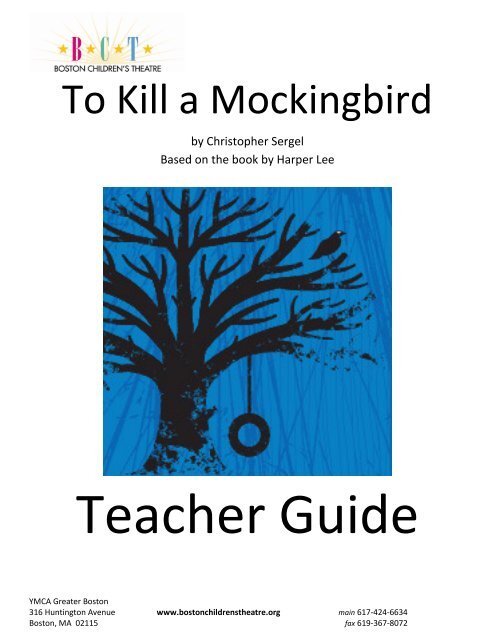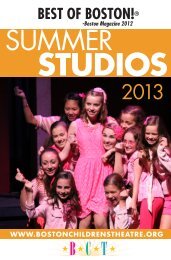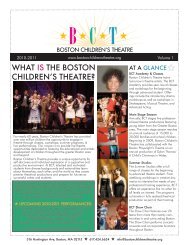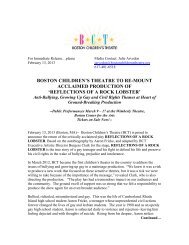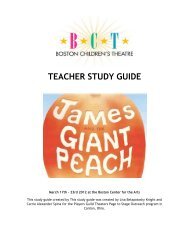To Kill a Mockingbird - Boston Children's Theatre
To Kill a Mockingbird - Boston Children's Theatre
To Kill a Mockingbird - Boston Children's Theatre
Create successful ePaper yourself
Turn your PDF publications into a flip-book with our unique Google optimized e-Paper software.
<strong>To</strong> <strong>Kill</strong> a <strong>Mockingbird</strong><br />
by Christopher Sergel<br />
Based on the book by Harper Lee<br />
Teacher Guide<br />
YMCA Greater <strong>Boston</strong><br />
316 Huntington Avenue www.bostonchildrenstheatre.org main 617-424-6634<br />
<strong>Boston</strong>, MA 02115 fax 619-367-8072
In This Guide<br />
<strong>Boston</strong> Children’s <strong>Theatre</strong> Information<br />
History of BCT, Upcoming class and audition information<br />
<strong>Theatre</strong> Etiquette<br />
Do’s and Don’ts of Audience Behavior<br />
<strong>Theatre</strong> Vocabulary<br />
Important terms to know<br />
Biographies<br />
Biographical information for Harper Lee and Christopher Sergel<br />
Activities & Crafts<br />
A list of activities and crafts that can be used to prepare for your theatre visit,<br />
or to follow up with your class after seeing our production.<br />
2
About <strong>Boston</strong> Children’s <strong>Theatre</strong><br />
<strong>Boston</strong> Children’s <strong>Theatre</strong> was founded in 1951 as a stand-alone, non-profit<br />
organization dedicated to presenting children’s theatre to a professional standard, offering<br />
“live theatre for children by children.” BCT is one of the oldest theatrical companies in the<br />
country.<br />
Since 1951 BCT has touched the lives of over one million children through its live<br />
classical and contemporary productions, classes, workshops, and summer programs. At BCT<br />
students have the opportunity to develop as they train for various roles and are responsible<br />
for all aspects of production. Students learn the inner workings of the theatre world and<br />
explore their internal selves through their work.<br />
<strong>To</strong>day, BCT offers a variety of opportunities for students including auditions, classes, and<br />
workshops, which are detailed below. <strong>Boston</strong> Children’s <strong>Theatre</strong> provides a unique<br />
opportunity for inner city and suburban kids to work together and has offered year-round<br />
opportunities for young performers and audiences that are accessible, available, and<br />
affordable for all families and youth.<br />
Currently BCT offers the following opportunities for children of all ages:<br />
Ongoing Auditions and Registration for various classes and productions<br />
Centerstage Discovery<br />
Centerstage Youth<br />
Mini Musicals!<br />
Music <strong>Theatre</strong> Scene Study<br />
Intermediate Acting<br />
Advanced Acting: The Actor’s Process<br />
Music <strong>Theatre</strong>: Scene to Song<br />
Master Classes: Music <strong>Theatre</strong> Dance, College Audition Review!, College Prep<br />
For more information on any of these opportunities, please contact the theatre.<br />
3
Audience Etiquette<br />
Coming to the theatre is a magical experience, much of that comes from the energy of<br />
the actors and the connections audience members make with the performers on stage. In<br />
order for the audience to have the opportunity to make these connections and enjoy their<br />
experiences, several guidelines are observed in live theatre audiences. Those guidelines are<br />
outlined here so that you may discuss them with your class and prepare students for what may<br />
be the first live theatre experience for many.<br />
Respect: Actors respect audience members by presenting their best work in a play.<br />
Audience members respect actors and others in the audience by keeping themselves quiet,<br />
still, and not talking during a performance. This includes talking to those around them, and<br />
talking or texting on a cell phone. These things distract from the performance and can disturb<br />
many of the people around you. Also, many theatres have their own rules that are always<br />
respected. For example, food is not allowed in many theatres, so snacks and drinks may be in<br />
the lobby, but inside the theatre, audiences are to focus on the performance so that they can<br />
really be engaged.<br />
Concentration and Listening: When audience members are focused on the performance<br />
and listening carefully to the actors on stage, they remember more of the play and can enjoy<br />
themselves as much as possible. If you are really listening there may be some parts of a play<br />
that make you laugh or make you feel sad. These things are great as long as you are in control<br />
of yourself and do not disrupt the performance. The more you concentrate on and react to<br />
the performance you are watching, the more you will be able to share when you get back to<br />
your classrooms or home with your families.<br />
Appreciation: Actors love when you appreciate their hard work, as long as you make<br />
sure you do it in an appropriate way and at the appropriate time. This is why audiences clap<br />
or applaud at the end of a great scene, or song, and always at the end of the whole<br />
performance. Clapping your hands lets the actors know you’re enjoying yourself and that you<br />
like what they’re doing. A few good times to clap are: at the end of a scene, when the stage<br />
goes dark, at the end of a song, when the curtain comes down on the stage, at the end of the<br />
first act or half of the play, and at the end of the play when the actors bow to the audience.<br />
4
<strong>Theatre</strong> Vocabulary<br />
There are many things that you will see in the theatre that you will not see in many<br />
other places. Here is a list of vocabulary words that help students get familiar with the theatre<br />
and some of the experiences they may have in the theatre, provided by the MA State<br />
Frameworks. See the Activities and crafts section for a <strong>Theatre</strong> Vocabulary word search.<br />
Casting: the selection of actors or performers.<br />
Character: a person, animal, or entity in a story, scene, or play with specific distinguishing physical, mental, and attitudinal<br />
attributes.<br />
Characterization: the process of creating a believable “person” by exploring the physical, social, and psychological dimensions of a<br />
role.<br />
Conflict: tension between two or more characters or between action and ideas; the fundamental struggle that leads to crisis and<br />
climax of a scene or play.<br />
Drama: a composition in verse or prose intended to portray a character, or tell a story through action and dialogue, and designed for<br />
theatrical performance.<br />
Ensemble: the harmonious blending of the efforts of the many artists involved in a dramatic activity or theatrical production.<br />
Gesture: the movement of a body part or combination of parts, with the emphasis on the expressive aspects of the move.<br />
Improvisation: the spontaneous use of movement and speech to create a character or object in a particular situation. An intuitive<br />
and immediate response rather than behavior that is rehearsed.<br />
Performance: the imitation of life in front of at least one other person. In a broad sense, performance refers to the presentation of<br />
any kind of entertainment, from play to rock concert, solo presentation to ensemble collaboration.<br />
Playwright: one who writes plays; dramatist.<br />
Properties (props): objects used on stage such as furniture, utensils, ornaments, and personal possessions.<br />
Puppetry: the art of making puppets or presenting puppet shows.<br />
Rehearsal: repeated practice in preparation for a public performance.<br />
Scenes: the subdivision of an act in a play, identified by place and time.<br />
Script: the written dialogue, description, and directions provided by the playwright.<br />
Stage manager: the head of the production staff who, once the play opens, takes charge of the stage, the actors, and the crews.<br />
Technical theatre: design and creation of sets, lighting, sound, properties, and costumes/makeup.<br />
5
Harper Lee<br />
Biographies<br />
Born Nelle Harper Lee on April 28, 1926, in Monroeville, Alabama. Lee Harper<br />
is best known for writing the Pulitzer Prize-winning best-seller <strong>To</strong> <strong>Kill</strong> a<br />
<strong>Mockingbird</strong>.. The youngest of four children, she grew up as a tomboy in a small<br />
town. Her father was a lawyer, a member of the Alabama state legislature, and<br />
also owned part of the local newspaper. For most of Lee’s life, her mother suffered<br />
from mental illness, rarely leaving the house. One of her closest childhood friends<br />
was another writer-to-be, Truman Capote <strong>To</strong>ugher than many of the boys, Lee<br />
often stepped up to serve as Truman’s protector. Truman, who shared few<br />
interests with boys his age, was picked on for being a sissy and for the fancy<br />
clothes he wore.<br />
In high school, Lee developed an interest in English literature. After<br />
graduating she went to College in Montgomery. Lee stood apart from the other<br />
students—she focused on her studies and on her writing. In her junior year, Lee<br />
was accepted into law school. After her first year in the law program, Lee began<br />
expressing to her family that writing—not the law—was her true calling. Returning<br />
to her law studies that fall, Lee dropped out after the first semester. She soon<br />
moved to New York City to follow her dreams to become a writer. While in the<br />
city, Lee was reunited with old friend Truman Capote, one of the literary rising<br />
stars of the time. She also befriended Broadway composer and lyricist Michael<br />
Martin Brown and his wife Joy.<br />
In 1956, Lee quit her job and devoted herself to her craft, and found an<br />
agent with The Browns’ help. Working with editor Tay Hohoff, Lee finished the<br />
manuscript in 1959. Soon Lee was engrossed her literary success story. In July<br />
1960, <strong>To</strong> <strong>Kill</strong> a <strong>Mockingbird</strong> was published and picked up by the Book-of-the-<br />
Month Club and the Literary Guild. The following year, <strong>To</strong> <strong>Kill</strong> a <strong>Mockingbird</strong> won<br />
the prestigious Pulitzer Prize and several other literary awards. Horton Foote<br />
wrote a screenplay based on the book and used the same title for the 1962 film<br />
adaptation. Lee visited the set during filming and did a lot of interviews to support<br />
the film. Earning eight Academy Award nominations, the movie version of <strong>To</strong> <strong>Kill</strong> a<br />
6
<strong>Mockingbird</strong> won four awards, including Best Actor for Gregory Peck’s portrayal of<br />
Atticus Finch. The character of Atticus is said to have been based on Lee’s father.<br />
During the 1970s and 1980s, Lee largely retreated from public life. She spent<br />
some of her time on a nonfiction book project about an Alabama serial killer,<br />
which had the working title The Reverend. But the work was never published. Lee<br />
continues to live a quiet, private life in New York City and Monroeville. Active in<br />
her church and community, she usually avoids anything to do with her still popular<br />
novel.<br />
Christopher Sergel<br />
Christopher Sergel's interests and talents led him on many adventures<br />
throughout the world. As captain of the schooner Chance, he spent two years in<br />
the South Pacific; as a writer for Sports Afield magazine, he lived in the African<br />
bush for a year; as a lieutenant commander during WWII, he taught celestial<br />
navigation; as a playwright, his adaptation of Sherwood Anderson's Winesburg,<br />
Ohio was seen on Broadway. But throughout his life, his greatest adventure and<br />
deepest love was his work with Dramatic Publishing. During this time, he wrote<br />
adaptations of <strong>To</strong> <strong>Kill</strong> a <strong>Mockingbird</strong>, Cheaper By the Dozen, The Mouse That<br />
Roared, Up the Down Staircase, Fame, Black Elk Speaks and many more. His love of<br />
theatre and his caring for writers made him a generous and spirited mentor to<br />
many playwrights here and around the world. His inspiration and integrity<br />
attracted to the company fine writers including C.P. Taylor, Timberlake<br />
Wertenbaker, Arthur Miller, Roald Dahl and E.B. White - to name just a few.<br />
7
Activities & Crafts<br />
In this section, you will find a number of activities that you can do with your<br />
class either to prepare for your visit to the theatre, or to reflect on the<br />
performance you saw together. All activities have many variations and can be<br />
added to and changed as needed for your students.<br />
Activity 1: Prepare for the Performance<br />
Read the novel with your class and use some of the following prompts for a discussion in<br />
class, either to prepare for the performance, or as a reflection activity after you view the<br />
performance.<br />
1. How do Jem and Scout’s views of Boo Radley change during the book? Why does Jem cry<br />
when the hole in the tree is filled with cement?<br />
2. Compare and contrast the play with the novel. What elements were the same, and which<br />
were different? Was there anything you felt could have been done differently in the play?<br />
What and how?<br />
3. Atticus tells the children several times that they need to walk in someone else's shoes<br />
before judging the person. Describe times when Atticus, Scout or Jem walk in someone<br />
else's shoes. How does this change how they view the situations? What role does this<br />
advice play in sympathy and compassion?<br />
4. Discuss race issues in this book. Why does Calpurnia speak differently around other black<br />
people? Why does Mr. Raymond pretend he is drunk to help people cope with his mixed<br />
marriage?<br />
5. How does the trial and everything surrounding it change the town? Change Jem and<br />
Scout? Did it change you?<br />
6. At the end of the book, Scout says that telling people Boo Radley committed the murder<br />
would have been "sort of like shootin' a mockingbird." What does that mean? Do you<br />
agree that Boo is like a mockingbird?<br />
8
Activity 2: Create a Matching Game for Studying<br />
After reading and discussing the story with your class, print the following template out<br />
into cards and play a matching memory game with them to focus on remembering important<br />
details from the story, and or characters. Make your own cards that focus on the topics<br />
important in your class if you like. Each student can have their own set and use them to<br />
prepare for the performance as well as studying for any classwork that may require them to<br />
recall these kinds of details.<br />
Runs away<br />
from home<br />
Takes Scout<br />
to church<br />
Who does<br />
Jem read to<br />
after school<br />
Saves Scout<br />
and Jem<br />
Is accused of<br />
rape<br />
Dill<br />
Calpurnia<br />
Mrs. Dubose<br />
Boo Radley<br />
<strong>To</strong>m Robinson<br />
Shoots the<br />
rabid dog<br />
House burns<br />
down<br />
Hates Scouts’<br />
overalls<br />
Owns the<br />
Maycomb<br />
Newspaper<br />
Attacks Scout<br />
and Jem<br />
Atticus<br />
9<br />
Miss Maudie<br />
Aunt<br />
Alexandra<br />
Mr.<br />
Underwood<br />
Bob Ewell
Activity 3: Sequence the Story<br />
Print and cut the following events or make your own, and allow each student to mix up<br />
and re-order the events of the story. This helps students remember the story in chronological<br />
order and can include any number of events to suit your classroom needs. The following are<br />
listed in the correct sequencing order.<br />
Scout and Jem meet Dill.<br />
Jem touches the Radley front door.<br />
Jem and Scout build a snowman.<br />
Miss Maudie’s house burns down.<br />
Scout fights her cousin Francis.<br />
Atticus shoots Tim Johnson.<br />
Aunt Alexandra comes to live in Maycomb.<br />
<strong>To</strong>m Robinson is shot trying to escape prison.<br />
Activity 4: Dramatize the Story<br />
Jem’s arm gets broken.<br />
Scout meets Boo Radley.<br />
After reading the story aloud to your class, this activity may be done either in groups or<br />
with all students simultaneously.<br />
1. If all students are working simultaneously: You should choose several of the more<br />
popular parts of the story, and act these things out together. Ask students how they<br />
feel as these characters and what connections they can make to the characters in the<br />
story. Students can also create frozen poses of their favorite character, and the rest<br />
of the class can guess which character they are portraying.<br />
10
2. If students are working in small groups: First, tell the students to choose a scene<br />
from the beginning, one from the middle, and one from the end of the play. In their<br />
groups they will first create a frozen image to represent each of the three scenes<br />
they chose. Next, they will show the scenes moving from one to the other in rolling<br />
action, but in pantomime, without sound. Finally, the students may choose one or<br />
two lines they would like to speak during their final rolling action. Focus should be<br />
on clear physical representation first, and speaking second in this exercise.<br />
3. A third option, if you have a smaller or a more advanced class is to actually dramatize<br />
as you read through the story again. Assign roles to students, and encourage them<br />
to act out what you are narrating as you read the story aloud.<br />
Activity 5: Write to the Cast<br />
Write to the actors (or draw a picture) about your favorite part of the play. Do you have<br />
questions for the performers, or the playwright? What would you like to know more about?<br />
What did you take away from the performance? Ask questions and share your own stories<br />
with the cast!<br />
Activity 6: Respond to the Play<br />
Write a review for the play, what were your favorite parts? What would you have<br />
changed about the play? What were some of the moments you remembered most? If you<br />
could, what part would you play and how would you do it?<br />
Discuss with your class connections they made to characters or moments in the play.<br />
Students can either write about these thoughts or simply share them with a discussion group.<br />
Discussions can also cover topics like: and/or questions students have about theatre and the<br />
performance.<br />
Activity 7: Create a Photo-Lit Collage<br />
The following activity is from http://faculty.buffalostate.edu/beaverjf/nbd/kill9.htm and<br />
is appropriate for older students. This activity allows students to deepen their understanding<br />
of the setting and time of the novel, as well as providing a visual aid for understanding that<br />
students who are more visually oriented will appreciate. Students will make connections with<br />
11
the story in another medium and will practice public speaking while explaining their collage<br />
choices.<br />
1. Select 6 photographs from the Great Depression which illustrate part of the setting of <strong>To</strong> <strong>Kill</strong><br />
a <strong>Mockingbird</strong><br />
2) Create a caption to describe each photo<br />
3) Select and include an excerpt or quote from the novel to explain the photos and captions<br />
4) Compile your photos, captions, and quotations to construct a collage<br />
5) Present your collage to a small group or to the class, explaining your choices<br />
Activity 8: Be a News Reporter<br />
Encourage students to take on the role of journalist or news reporter and engage in one<br />
of the following activities. Students will imagine themselves in the depression era and will<br />
cover the <strong>To</strong>m Robinson trial from their point of view, following one of the guidelines.<br />
1. Write a news article describing the outcome of <strong>To</strong>m Robinson's trial<br />
2. Revise the outcome of <strong>To</strong>m Robinson's trial the way you believe it should end, then<br />
perform a skit for the class portraying the new ending.<br />
3. Make a video of a news broadcast reporting on <strong>To</strong>m Robinson's trial, then show the<br />
video to the class.<br />
Activity 9: Make Your Own Board Game<br />
Create a game board tracing Scout and Jem’s journey through <strong>To</strong> <strong>Kill</strong> a <strong>Mockingbird</strong>. At<br />
the various spaces players land on which are pivotal to events in the text, such as Mrs.<br />
Dubose’s house, write a card in which you question the player about what Scout and Jem<br />
learned at that place on the board. Accompany your game board with an explanation of how<br />
your game reflects the plot, setting, characters, and themes in the novel. Use game pieces<br />
that reflect a part of the story, and explain that in your presentation as well. Have a game day<br />
in your class where all students can play each other’s games and share their work with each<br />
other.<br />
12
Activity 10: <strong>Theatre</strong> Vocabulary Word Search<br />
Encourage your students to find the theatre vocabulary words in the search below.<br />
(Definitions provided in the THEATRE VOCABULARY section earlier in the guide) Words can be<br />
found in any direction.<br />
Casting<br />
Character<br />
Characterization<br />
Conflict<br />
Drama<br />
Ensemble<br />
Gesture<br />
Improvisation<br />
Performance<br />
Playwright<br />
Props<br />
Puppetry<br />
Rehearsal<br />
Scenes<br />
Script<br />
Stage Manager<br />
Technical <strong>Theatre</strong><br />
Z I Q W E R T G E S T U R E<br />
K M Y U I T O G N I T S A C<br />
P P S A P E D F S G N H J K<br />
U R V C S C E N E S O X Z L<br />
P O O B N H M B M Q I W S J<br />
P V I P O N P G B V T K T C<br />
E I U E S I Y T L R A E A O<br />
T S F R D C S A E Q Z W G N<br />
R A G F H A H J K L I M E F<br />
Y T Z O X L C A V B R N M L<br />
J I A R S T T D R F E G A I<br />
F O Q M L H P K J A T H N C<br />
Y N W A E E I R T Y C U A T<br />
V Q N N M A R P A O A T G I<br />
W C B C V T C C X M R Z E W<br />
R E H E A R S A L J A K R R<br />
K X Z V Y E B I R Q H R O D<br />
P L A Y W R I G H T C N D F<br />
13


